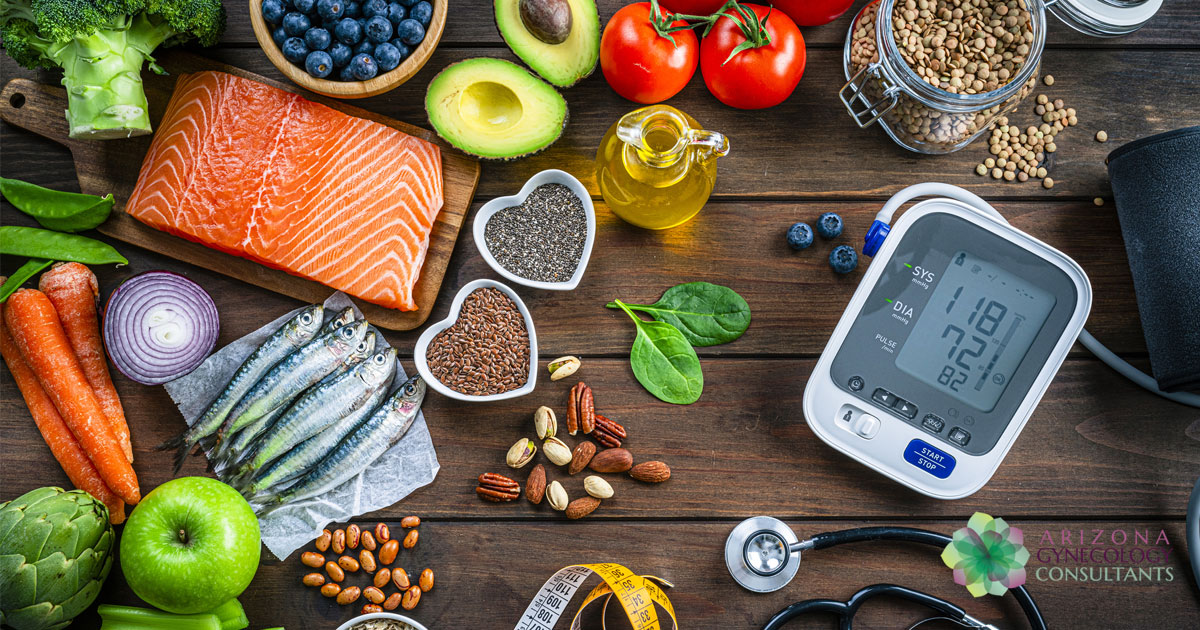Weight goals don’t come to fruition without weight loss education. At Arizona Gynecology Consultants, our weight loss program is individualized to each patient’s unique metabolic needs, personal goals, and lifestyle obstacles. Each provider will guide you in discussing your weight loss challenges, previous modalities, hormones, nutrition, exercise, and each medical management option available.
A key component in being successful is sticking with a good nutritional plan, exercising, and sleep hygiene. Your provider will have a visit once a month to check vital signs, answer lifestyle questions, adjust nutritional needs, and even recheck labs to show how your body is responding to your daily efforts and accomplishments.
Weight Loss Education: Macronutrients and Calories
Carbohydrates, proteins, and fats are the main types of macronutrients in food. All three provide energy (measured in calories), but the amount of energy in 1 gram differs. When looking to decrease the intake of daily calories to lose weight, we want to focus on eating complex carbohydrates and proteins.
Calories per gram in each macronutrient:
- 4 calories in a gram of carbohydrate or protein
- 9 calories in a gram of fat
These nutrients also differ in how quickly they supply energy. Carbohydrates are the quickest, and fats are the slowest. If you eat a bag of chips, you may notice you are hungry again in one hour due to the quick metabolism of carbohydrates. Therefore, choosing a snack high in protein will keep you full longer and have less calories.
Carbohydrates, proteins, and fats are digested in the intestine, where they are broken down into their basic units:
- Carbohydrates into sugars
- Proteins into amino acids
- Fats into fatty acids and glycerol
So, losing weight requires being in a calorie deficit!
What Is a Calorie?
A calorie is a unit of measurement that describes the amount of energy acquired from food and drinks. As noted above you see that fats hold higher calories when eaten. When we eat something, our bodies break it down and transform it into energy, which we use for activities like breathing, circulation, digestion, and movement. The quantity of energy required by everyone differs depending on activity level, age, gender, and metabolism.
What Is a Calorie Deficit?
A calorie deficit is achieved when the body burns more calories than it consumes through food and drink. When we eat less calories per day, the body will take from stored energy reserves such as fat tissue. As the body uses its fat stores for fuel, this can contribute to weight loss over time. When we overindulge on high calorie foods, we must burn these calories by physical activity to remain in a calorie deficit. The goal is to decrease caloric intake to 25% less than your total daily energy expenditure. Athletes need to eat calorie and protein dense meals as they are active for many hours each day. Everyone requires different needs based on lifestyle and calories burned by working or physical activity.
A deficit of 500 calories per day, which amounts to 3500 calories per week, should result in about one pound of weight loss per week. This basic equation is just with nutrition changes alone! Mathematically you can see that consistent calorie deficit is necessary for long-term weight loss.
Eating Low-Calorie and Nutrient-Dense Foods
Have you noticed how colorful your food is each day? If your diet consists of many fats and carbohydrates your plate is likely to be white, beige, or brown in color. Make it a goal to eat colorful foods that provide vitamins and nutrients in each meal. Such foods are fruits, vegetables, lean meats, whole grains, nuts, and fish. Eating fiber-rich foods like whole grains, fruits, and vegetables will help you stay full for a long time, limiting your overall calorie intake.

Limit your intake of high-calorie and low-nutrient foods and beverages such as sugary drinks, fried foods, and sweets. Processed foods and beverages tend to be high in simple carbohydrates, fats, and refined sugars. These foods hold zero vitamins or nutrients. Home cooked meals are encouraged in our program to limit the consumption of refined sugars, fried foods, or carbohydrate rich meals.
What Is Protein?
Proteins function as building blocks for bones, muscles, cartilage, skin, and blood. They also strengthen our bones, muscles, cartilage and help cellular repair. Protein rich foods contain amino acids, B vitamins, selenium, choline, zinc, phosphorus, copper, vitamin D, A, and E vitamins.
Based on the National Institutes of Health, the Recommended Dietary Allowance (RDA) for protein is a modest 0.8 grams of protein per kilogram of body weight. The RDA is the amount of nutrients you need to meet your basic nutritional requirements. This measurement is the minimum amount an individual needs to maintain health and cellular restoration.
To determine your daily protein intake, you can multiply your weight in pounds by 0.36. For a woman who weighs 140 pounds and who is sedentary (does not exercise), that translates into 53 grams of protein a day. This is the minimum amount of protein required to meet the body’s needs and supports a healthy weight.
Examples of high protein foods:
- chicken breast
- tuna
- tofu
- cottage cheese
- beans
- lamb
- milk
- lean beef/steak/pork
- shrimp
- eggs
- lentils
- quinoa
- seeds
- protein powder/bars
- salmon/fish
- turkey
- Greek yogurt
- edamame
- nuts
- cheese
- shellfish
What Is a Carbohydrate?
Carbohydrates are the sugars, starches, and fibers found in fruits, grains, vegetables, and milk products. Carbohydrates are the body’s main source of fuel and are broken down into sugars. These sugars are absorbed with digestion and cause elevated sugar levels in the blood. With the help of insulin, the glucose enters the cells and fuels our activities. As you can tell carbohydrates are necessary! However, when there is extra glucose in the bloodstream it is stored and converted into fat cells. The intake of carbohydrates is limited in our weight loss program to 50 grams per day. If a patient has a heavy exercise routine or weight lifts, then these grams per day will change due to the body’s need for energy. Also, we have patients focus on complex carbs rather than simple carbs.
There are three main types of carbohydrates:
- Sugar – Sugar is the simplest form of carbohydrate. It occurs naturally in some foods, including fruits, vegetables, milk and milk products. Types of sugar include fruit sugar (fructose), table sugar (sucrose) and milk sugar (lactose).
- Starch – Starch is a complex carbohydrate. This means it is made of many sugar units bonded together. Starch occurs naturally in vegetables, grains, and cooked dry beans and peas.
- Fiber – Fiber also is a complex carbohydrate. It is found in fruits, vegetables, whole grains, and cooked dry beans and peas.
Complex vs. Simple Carbohydrates
Carbohydrates are classified as complex or simple based on their chemical structures and how quickly the sugar is digested and used for energy. In order to maintain weight loss, many studies show that we consume complex carbs and avoid simple carbs.
Complex carbohydrates have three or more sugars, digest slower, and provide a more sustained energy source. These contain higher levels of fiber that can also provide a feeling of being fuller longer.
Simple carbohydrates have just one or two sugars and are made with refined sugars or processed sugars. These carbs do not contain vitamins, nutrients, or fiber. It is suggested to avoid these high caloric carbohydrates. Weight loss requires eliminating simple carbohydrates as they are “empty calories” and hold no nutritional value to the body.
Examples of complex carbs:
- beans/legumes
- peanuts
- vegetables
- brown rice
- peas
- corn
- fruit
- potatoes
- lentils
- whole grain bread
- oats
- quinoa
Examples of simple carbs: Try to avoid these.
- soda/pop
- sugary coffee
- cookies
- candy
- fruit juice
- white bread
- cake
- chocolate
- energy drinks
- pastries
- ice cream
- french fries/ chips
What Is Fat?
The highest macronutrient in caloric breakdown (9 calories per gram) is fat. There are different forms of fats and some are healthier than others. The Dietary Guidelines for Americans suggest that less than 10% of calories a day should be from saturated fats, which is about 13 grams per day allowed. Furthermore, even lower is The American Heart Association suggests a goal of 5% of daily calories from saturated fats. Saturated fats are known to cause an elevation in bad cholesterol (LDL) and good cholesterol (HDL). Your provider will check lipid panel, as high cholesterol can lead to plaque buildup in the arteries that can precede cardiovascular disease.
Saturated fats – Saturated fats are usually solid at room temperature. The most common sources of saturated fats are meats and dairy products.
Unsaturated fats – Unsaturated fats are usually liquid at room temperature. Vegetable oils, nuts and fish have mostly unsaturated fats. There are two types of unsaturated fats: monounsaturated and polyunsaturated. The American Heart Association does recommend the majority of fats you consume are unsaturated.
Foods high in saturated fats include:
- fried foods
- lamb
- butter
- cheese
- baked goods
- pork
- creams
- chocolate
- beef
- poultry with skin
- whole milk
- dairy products
Monounsaturated fats are from plants and may lower bad cholesterol and raise good cholesterol. They also may improve the control of blood sugar levels. Replacing saturated fats with monounsaturated fats in the diet may lower the level of bad cholesterol and triglycerides in the blood. Triglycerides are fat cells that circulate in the bloodstream and are stored in the body’s fat cells. Eating plant foods high in monounsaturated fats, particularly extra virgin olive oil and tree nuts, may benefit heart health and blood sugar regulation.
Examples of Monounsaturated fats:
- avocado
- sesame oil
- salmon, halibut, herring
- olives
- almonds, cashers, peanuts
- cheese
- peanut oil
- pecans, pistachios
- dark chocolate
How to Read Nutrition Labels
Our weight loss program encourages keeping the total carbohydrates under 50 grams per day, sugars less than 30 grams per day, and meeting the body’s protein intake based on body weight per day (average is 50-100 grams per day if not exercising).
Below are two different labels from yogurts found at your grocery store. Once you learn to read labels, you will be able to meet your daily health goals! These yogurts are very similar in design and advertising but take a closer look at the amount of carbs and sugars.
Calories 210: Fat 8g, Carbs 25g, Sugars 23g

Calories 90: Fat 2g, Carbs 3g, Sugars 2g
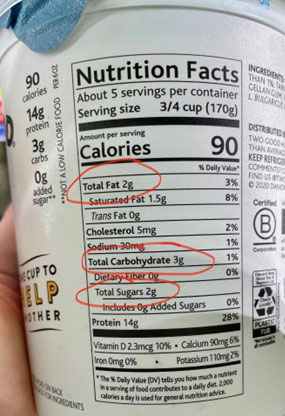
Reading labels is key to keeping your carbohydrates, proteins, fats, and sugar intake goals throughout your weight loss journey! Many food items are labeled as high protein and low sugar, but not until you turn each item around and read the label will you truly know the grams per calorie you are consuming.
Another example of the importance of reading labels is found in meal replacement shakes or “healthy protein drinks.” The shake on the right has almost FOUR TIMES the amount of carbohydrates! Remember carbohydrates break down into sugars, which in excess will turn into fat cells. The less carbohydrates and sugars, the better.
The low carb protein shake with
Carbs 3g, Sugars 1g, Protein 22g
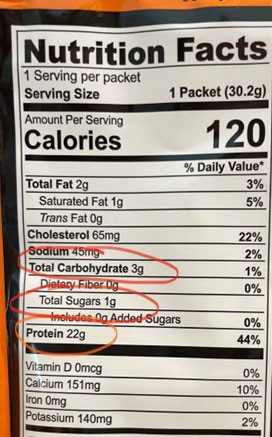
The higher carb protein shake with
Carbs 11g, Sugars 1g, Protein 20g
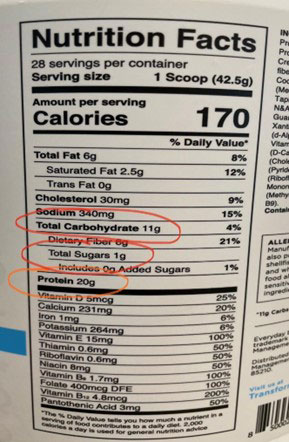
*The total macronutrients within protein shakes are also different with brands of protein bars*
Refined Sugars in Drinks
One more example of hidden calories, carbohydrates, and sugar comes from COFFEE. Now that you know what to look for on ingredient labels, compare these three options from a popular coffee shop. One coffee can maximize or even double your recommended carbohydrate and sugar daily intake! Excess sugars will turn into fat cells that will lead to weight gain.
Iced Energy Drink

Worst drink option
Vanilla latte/breve

Bad
Americano
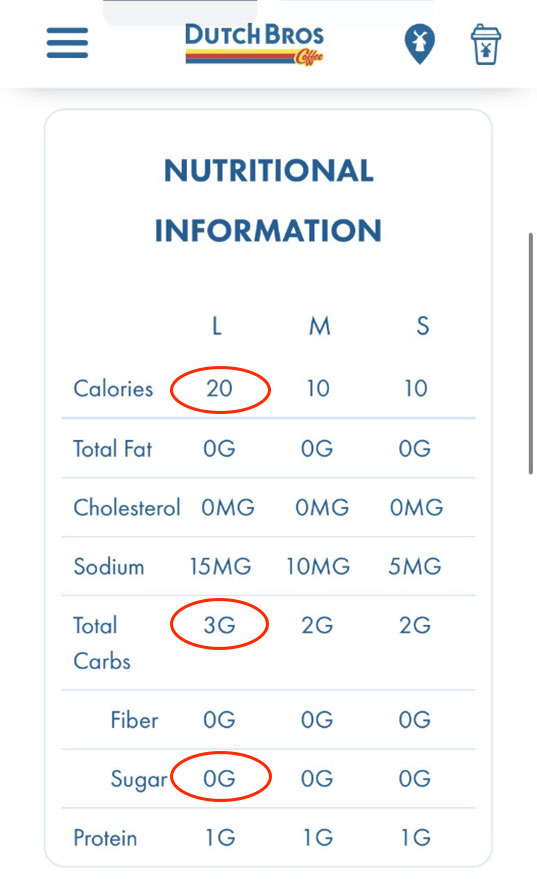
Best option
Options for low calorie and high protein foods:
- boiled eggs
- beef/turkey jerky
- lean turkey and cheese rolls
- cottage cheese and berries
- mixed nuts
- edamame
- salad with lean meat
- protein smoothie
- peanut butter and celery
- cucumbers and light dressing
- string cheese
- chicken or tuna salad
- hummus and veggie sticks
- Greek yogurt and chia seeds
- protein bar
- shrimp and cauliflower rice
- quinoa and chicken bowl
- spaghetti squash and ground turkey
- plantain chips
Daily Checklist For Weight Loss Success
- Keep total carbohydrates less than 50 grams per day
- Keep total sugars less than 30 grams per day
- Consume minimum grams in protein per body weight needs 50-100 grams
- Avoid refined sugars, fats, processed/fried foods, sugary drinks, alcohol
- Drink half your weight in ounces of water per day
- Sleep 7-8 hours each night
- Walk at least 5,000 steps per day
- Exercise at least 150 minutes per week
It is recommended by the American Heart Association that every person gets at least 150 minutes per week of aerobic activity. Including muscle strengthening activities twice a week. Exercise has been proven to decrease the risk of chronic diseases such as diabetes, cardiac failure, dementia, and depression.
Arizona Gynecology Consultants for Weight Loss Education

We offer a medically assisted weight loss program for women in Arizona, customized and focused on strategies that bring consistent results. Many women struggle with a cycle of weight loss and gain. Learn integral lessons about nutrition, your body, and healthier habits. Contact Arizona Gynecology Consultants to book an appointment at a time that is convenient for you.
This site has an abundance of information regarding macronutrients, examples of foods, recipes, grocery lists, and more!

Nurse Practitioner
Ashley is a board certified Nurse Practitioner who is excited to follow her passion back into women’s health. She has five years of experience as a Nurse Practitioner in family medicine, as well as, five years of bedside experience in high risk labor and delivery.
Ashley is a native of Illinois, but moved to Arizona in 2015 to accelerate her nursing career. She achieved her Bachelor’s of Science in Nursing from Clarke University in Dubuque, Iowa where she also played volleyball. While working as a nurse in 2017 at Banner University Medical Center, she completed her Master’s of Science in Nursing at Chamberlain College of Nursing.

